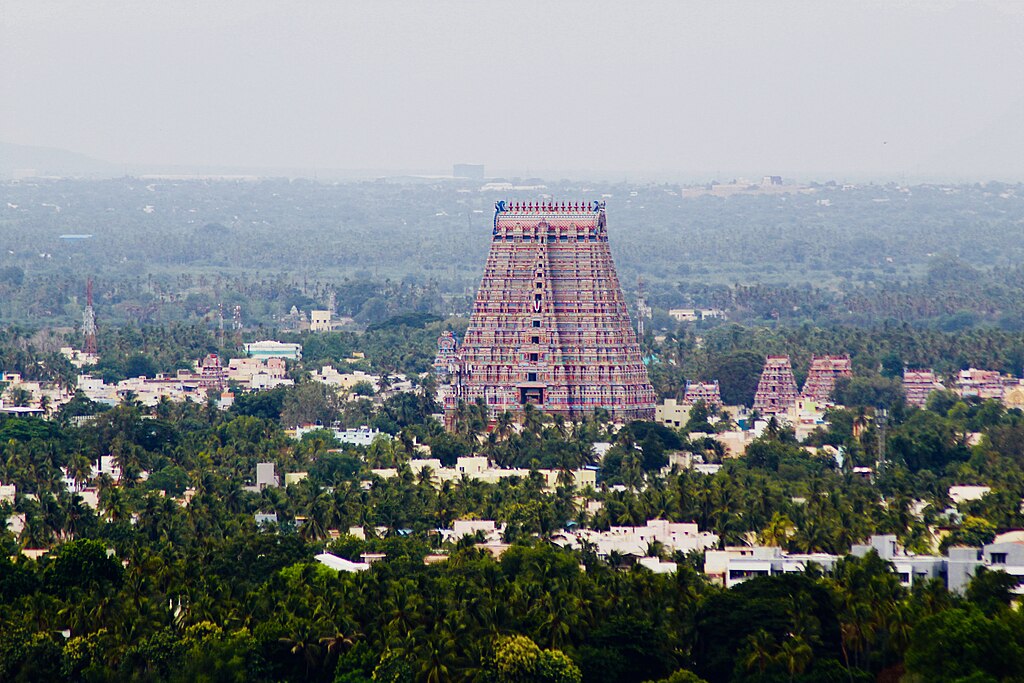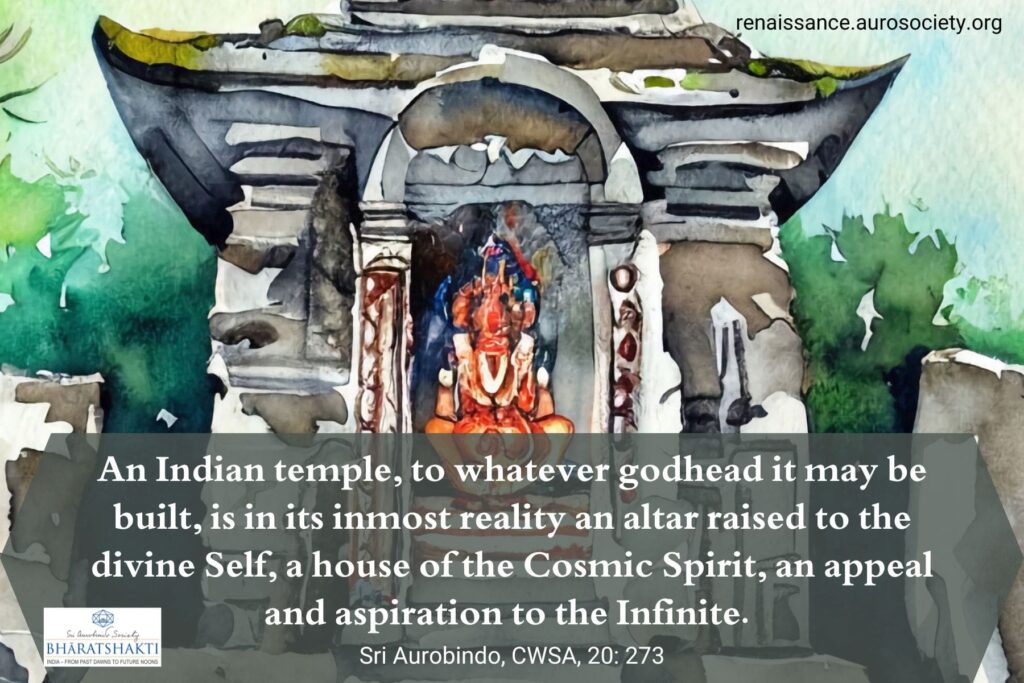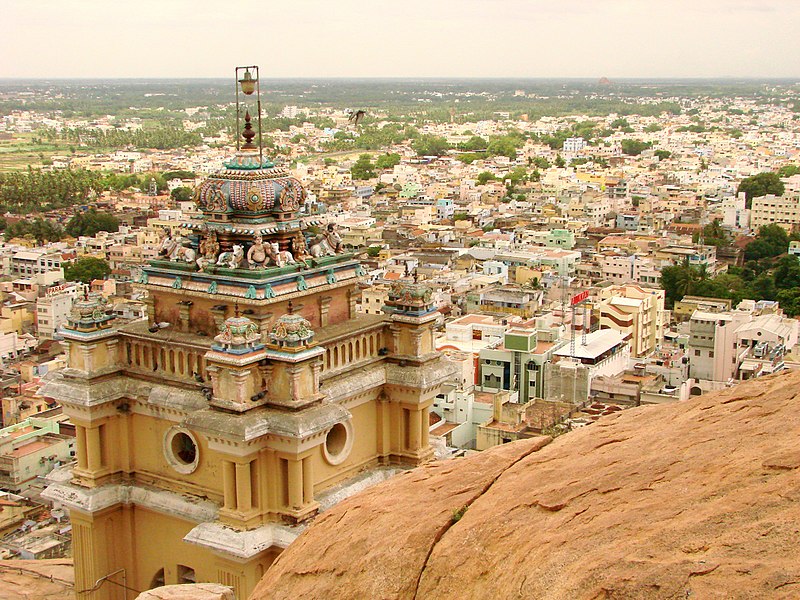Date: July 22, 2025
Part 3: Trichy – The Glorious Splendour of the Divine
Tiruchirappalli, more commonly known as Trichy, is the quintessence of the glory of the externalisation of Indian spiritual culture that evolved to a zenith in the Tamilakam region and still remains unique to itself. The bustling large town has retained the colour, pomp, sound and smell of the ancient ceremonial existence along with the religious and spiritual essence that is palpable in the very nerve and fibre of the people and place.
Women draped in Kanjivaram sarees with their hair adorned in colourful flowers, the art and skill of kolam spread over the roads, the rhythms of Bharatanatyam, the melody of Thyagaraja keertanas mixed with the chartbusters of their much-loved yesteryear matinee idol MGR, unmistakable fragrance of sambar and hot foaming filter coffee and beneath all these is their love for Sri Ranganathaswamy and their warm hospitality towards His devotees who swarm the town in large numbers.
Ranganatha himself is undisturbed in his yoga-nidra, in the beautifully carved reclining posture, huge and imposing but awe-inspiring vigraha in the sanctum sanctorum of the Srirangam temple that is wrapped in seven prakaras with fort walls encircling several shrines of deities and their inspiring stories. This outstanding marvel of sculpture reminds us of the narration of the Mother when she encountered the reclining god in occult worlds. In her own words,
“And there I suddenly found myself in front of something like a vault or a grotto (of course, it was only something ‘like’ that), and when it opened, I saw a Being of iridescent light reclining with his head on his hand, fast asleep. All the light around him was iridescent. When I told Theon (Her occult master) what I was seeing, he said it was ‘the immanent God in the depths of the Inconscient,’ who through his radiations was slowly waking the Inconscient to Consciousness.
“But then a rather remarkable phenomenon occurred: when I looked at him, he woke up and opened his eyes, expressing the beginning of conscious, wakeful action.”
Listen on Spotify:
The Mother on Avatar

In Bhagavad Gita, Sri Krishna says,” sarvasya chāhaṁ hṛidi sanniviṣhṭo” (I am in the heart of everything). The Divine consciousness pervades and supports all the worlds from the most nether inconscience to the highest Brahman beyond all creation.
The land that gifted the world with the mesmerizing form of the Cosmic Dance of Nataraja, is exquisitely enriched by countless eminent Divine saints, scholars and composers. Sri Vaishnavism is a delightful combination of enlightened intellect, ravishing many-sided bhakti for the Lord and the superb artistry and craftsmanship of external decorations, song and dance of the temple festivals.
Ramanujacharya, the noted philosopher-saint and chief proponent of Vishishtadvaita (qualified non-dualism) school of Vedānta was one of the most important exponents of the Sri Vaishnavism tradition rooted in Bhakti for the Personal god. Sri Aurobindo explains that in this marga even the lower recalcitrant human emotions are compelled to turn towards the Divine that aid in the ascent towards the inner union with the Divine while leaving an indelible mark and symbol of ritual and custom for posterity to emulate and imbibe.
“But the old spirituality reigned behind all this mental and all this vital activity, and its later period, the post-classical, saw a lifting up of the whole lower life and an impressing upon it of the values of the spirit. This was the sense of the Puranic and Tantric systems and the religions of Bhakti.
“Later Vaishnavism, the last fine flower of the Indian spirit, was in its essence the taking up of the aesthetic, emotional and sensuous being into the service of the spiritual.”
~ Sri Aurobindo, CWSA, 20: 13
The story of Andal, the poetess-devotee, illumines us as to how the human part of the Lord aspires, purifies in immense devotion and passion for the Lord and ultimately merges her spirit in Ranganatha.
The traveller of the inner worlds will pause at each of the main shrines in the prakaras, hear the inspiring stories of the saints and gods that help us navigate the inner spheres – Andal, Dhanvantari, Nathamuni, Nammalvar, Vedanta Desikan and many more. When the temple was ravaged by iconoclasts, these devoted souls did not care for their lives in preserving the idols around whom their entire lives were woven.
Read in Renaissance:
Devotee as the Deity – Srivilliputhur Andal Temple
Shunning all speculations of rivalry between the two great cosmic powers, the town harbours a massive temple of Shiva too, called Jambukeswara Temple. Shiva is represented as Jala Linga.
Long before the cellular or atomic theories were floated, the Rishis of Bharat knew that everything in creation is constituted by the five elements – air, water, fire, earth and ether. By building a temple of Shiva in the name of each of these elements, this understanding is brought into common parlance. From the temple architecture to the various images of the gods and the rituals, everything is a microcosm of the cosmic principles and powers. Shiva is the primordial energy, a stage before creation is constituted.

Temple ceremonies brought the Divine closer to the masses whose imagination is yet externalised and look for outer anchors for inner truths while the rituals also connect the physical to the spiritual.
These temples also carry the stories of the powerful Southern royal dynasties, the Cholas, Pandyas, Pallavas and Nayaks who carried the culture beyond the shores. They were known for their valour as much as their commitment to their deities. They epitomised and endeavoured to perfect the Kshatra (warrior) dharma aspect of the Absolute.
Another important temple is Ucchi Pillayar Temple, popularly known as Rock Fort Temple, dedicated to Ganesha who prevented Vibhishana, Ravana’s brother, from taking Ranganathaswamy’s murti to Lanka. Standing at the top of the 272 feet high rock where the temple is built, one is enthralled by the city views, the curves of Kaveri and the unique architecture of this temple.

The bountiful waters of river Kaveri have always been soothing to the eyes. The sacred river has also inspired many a composer and a philosopher. Originating in the Kamandalu (water pot) of sage Agastya, the river is worshipped as a goddess and a mother. The subtle spiritual omnipresence of the divinity in all physical existence and the capacity of the men to enter into contact with the spirit of all nature — rivers, mountains, rains, wind, trees and stones — is emphasised in all the Puranic stories.
Trichy is an experience of Indian Culture through senses, emotions, intellect and psychic. But the seeker on the path of Integral Yoga realises that it is not sufficient that the lower planes of man rise to the Divine in an ascent of prayer and aspiration. In the past, the prayer was always for only the liberation and inner union. But there must also be a Descent of the Higher spheres and powers into the lower parts of man, thus divinising and transforming Nature and Life.
